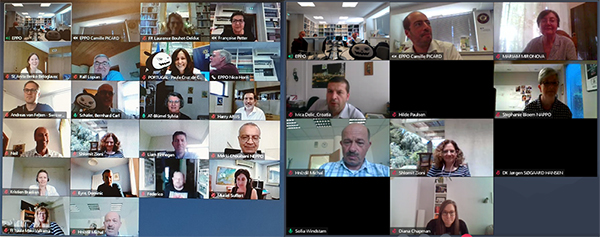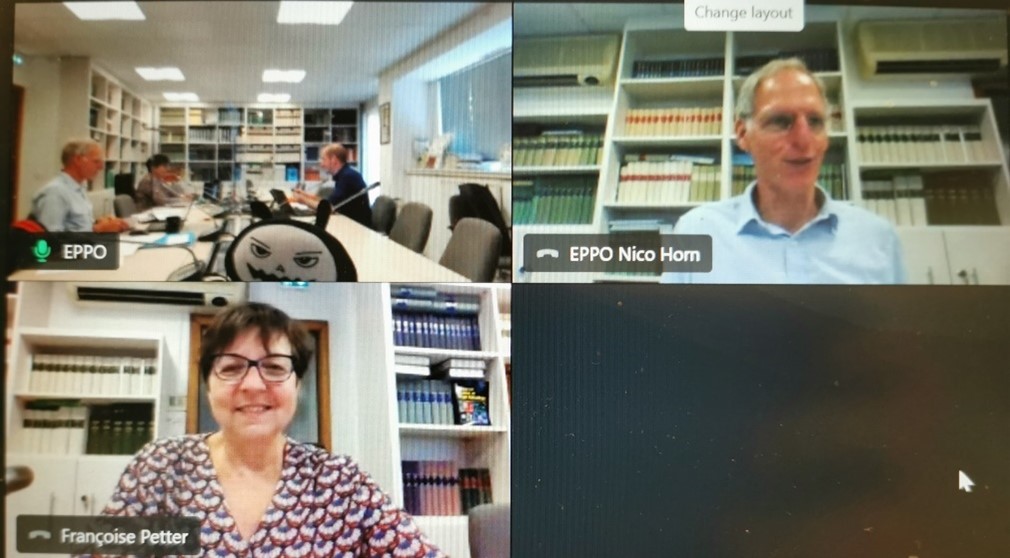
59th Meeting of the Working Party on Phytosanitary Regulations
Teleconference, 2021-06-16/18
The meeting of the Working Party on Phytosanitary Regulations met by videoconference due to the COVID-19 pandemic. There were 35 participants from 26 EPPO countries and observers from the European Commission, EU Council, NAPPO, NEPPO and USDA-APHIS. This EPPO Working Party directs and supervises the technical work of many EPPO Panels related to plant health. A summary of the different Panel meetings and Workshops which took place since the last meeting was presented to the Working Party (short summaries of these meetings are posted on this website ![]() ). The Working Party also discussed the work programme for 2022 and made several recommendations that will be presented to the EPPO Council.
). The Working Party also discussed the work programme for 2022 and made several recommendations that will be presented to the EPPO Council.

New and revised EPPO recommendations and Standards
The Working Party recommended that 4 new pests (including an invasive alien plant) should be added to EPPO Lists of pests recommended for regulation as quarantine pests: Chrysobothris femorata, C. mali and Orgyia leucostigma to the EPPO A1 List of pests absent from the region; Celastrus orbiculatus to the EPPO A2 List of pests present in the region. For each pest, recommended phytosanitary measures are described in a Pest Risk Analysis which will be made available via the EPPO PRA platform ![]() .
.
18 new and revised Standards were considered ready to be presented for approval at Council:
- Phytosanitary Procedures (series PM3)
- Consignment inspection of fresh fruit and vegetables for fruit flies (new)
- Trees of Malus, Pyrus, Cydonia and Prunus spp. – inspection of places of production (revision of PM 3/76)
- Consignment inspection of seed and grain of cereals (revision of PM 3/78)
- Consignment inspection of seed of Solanum lycopersicum (revision of PM 3/80)
- Testing of potato varieties to assess resistance to Globodera rostochiensis and Globodera pallida (revision of PM 3/68)
- Management of phytosanitary risks for potato crops resulting from movement of soil associated with root crops and potatoes (new)
- Guidelines on Pest Risk Analysis (series PM5)
- Guidelines on the design and implementation of a buffer zone (new)
- Guidelines on the phytosanitary measure ‘Plants grown under complete physical isolation’ (revision of PM 5/8: alternative title)
- Safe use of biological control (series PM 6)
- List of Biological Control Agents used in the EPPO region without recognised adverse effects (revision of PM 6/3)
- Diagnostic protocols for regulated pests (series PM 7)
- Basic requirements for quality management in plant pest diagnosis laboratories (revision of PM 7/84)
- Specific requirements for laboratories preparing accreditation for a plant pest diagnostic activity (revision of PM 7/98)
- Guidelines for the production of biological reference material (new)
- Commodity-specific phytosanitary measures (series PM 8)
- Acer (new)
- Platanus (new)
- Tilia (new)
- National Regulatory Control Systems (series PM9)
- Ambrosia trifida (new)
- Ambrosia artemisiifolia (revised PM 9/7)
- Pontederia crassipes (revised PM 9/8)
The Working Party also noted the adoption of the following Diagnostic Protocols (series PM 7) approved since its last meeting according to the specific fast-track procedure:
- Pospiviroids (genus Pospiviroid) (new)
- Xanthomonas arboricola pv. pruni (revised PM 7/64)
- Phyllosticta citricarpa (revised PM 7/17)
- Longidorus diadecturus (new)
- Clavibacter sepedonicus (revised PM 7/59)
- Lycorma delicatula (new)
- Tomato brown rugose fruit virus (new)
- DNA barcoding as an identification tool for a number of regulated pests (revised PM 7/129)
- Anoplophora glabripennis and Anoplophora chinensis (new)
- ‘Candidatus Liberibacter africanus’, ‘Candidatus Liberibacter americanus’ and ‘Candidatus Liberibacter asiaticus’ (revised PM 7/121)
- ‘Candidatus Phytoplasma phoenicium’ (new)
- Guidelines for the management of nematode collections used for the production and maintenance of reference material (new)
The Working Party recommended that the following Standards are withdrawn:
- Tomato ringspot nepovirus in fruit trees and grapevine - Inspection methods (PM 3/32)
- Other viruses of Malus and Prunus - Inspection and test methods (PM 3/33)

Information services
The Working Party was updated on the ongoing ‘datasheet’ project performed under a grant agreement between EPPO and the European Commission and consisting of developing/revising datasheets for 320 pests between 2020 and 2024. Since the beginning of the project, 101 datasheets have been published in EPPO Global Database and 82 are in progress.
The Working Party reviewed the suggestions for deletion of pests from the Alert list and was informed of the additions made since the last meeting. The Alert List draws the attention of EPPO member countries to certain pests possibly presenting a risk to them in order to achieve early warning.
Diagnostics
The EPPO Secretariat presented the progress made on the EPPO-Q-bank database ![]() and reported on the result of a questionnaire to laboratories asking them about their willingness and capacity to provide data on biological material via EPPO-Q-bank. Although responses were generally positive, the Working Party considered that because of the limited number of responses, the possibility to establish a collection database should be reconsidered at a later stage. The Working Party was also briefed on the outcomes of the EU funded VALITEST Project
and reported on the result of a questionnaire to laboratories asking them about their willingness and capacity to provide data on biological material via EPPO-Q-bank. Although responses were generally positive, the Working Party considered that because of the limited number of responses, the possibility to establish a collection database should be reconsidered at a later stage. The Working Party was also briefed on the outcomes of the EU funded VALITEST Project ![]() in particular the three series of online training workshops coordinated by the EPPO Secretariat and the development of the new EPPO Standard Guidelines for the production of biological reference material (see above). Outcomes of the project will be used for the revisions of existing Standards on validation (PM 7/98) and interlaboratory comparisons (PM 7/122 Guidelines for the organization of interlaboratory comparisons by plant pest diagnostic laboratories) and the preparation of a new Standard on HTS will start in the Autumn 2021.
in particular the three series of online training workshops coordinated by the EPPO Secretariat and the development of the new EPPO Standard Guidelines for the production of biological reference material (see above). Outcomes of the project will be used for the revisions of existing Standards on validation (PM 7/98) and interlaboratory comparisons (PM 7/122 Guidelines for the organization of interlaboratory comparisons by plant pest diagnostic laboratories) and the preparation of a new Standard on HTS will start in the Autumn 2021.
PRA activities
The Working Party agreed that Expert Working Groups (EWGs) for PRA should be organized for the invasive alien plants Solanum viarum and S. carolinense, and, by order of priority, on Dendroctonus valens (Scolytidae damaging pine trees), tomato mottle mosaic virus and Tetranychus mexicanus (Acari damaging fruit trees and ornamentals).
The Working Party prepared a statement to be presented to Council on beech leaf disease.
Phytosanitary measures
The Working Party suggested that EWGs are held in 2022 to draft a Standard PM 3 on Post-entry quarantine for Vitis and to revise Standard PM 3/66 Guidelines for the management of plant health risks of biowaste of plant origin. In addition to the ongoing revision of PM 4/17 Pathogen-tested olive trees and rootstocks, the Working Party recommended that the revision of PM 4/28 Certification scheme for seed potatoes is launched before a decision is made on the revision of other PM 4 Standards.
After a discussion on listing of pests below the species level, the Working Party concluded that this is difficult at EPPO level and that any recommendation will be limited to specific cases and adequately justified.
In order to ensure consistency between EPPO recommendations on phytosanitary measures, an Excel file compiling EPPO recommended Risk management measures was prepared. This file will be made available in 2021 on the restricted part of the PRA platform ![]() .
.
A revised guideline to review non-EPPO PRAs to prepare EPPO recommendations for pest listing was approved.
The Working Party approved the measures recommended for Citrus bark cracking viroid in an EPPO PRA report. The Working Party was also informed of the results of the questionnaire on PM 3 Standards which confirmed the importance and use of these Standards.
Biological Control Agents
The Working Party agreed with the Panel proposal to add Anastatus bifasciatus, Heterorhabditis downesi and Eupeodes corollae to Standard PM 6/3 List of biological control agents widely used in the EPPO region. The Working Party approved the procedure for addition/deletion of BCAs to the list which was revised for clarification and to provide a standardized format for the applications.
Plant Health Links in the EPPO Region
The following issues were discussed:
- EPPO activities in the context of the International Year of Plant Health 2020
- ePhyto
- IPPC Sea Container Task Force
- Collaboration between EFSA and EPPO
- Collaboration between NAPPO and EPPO
- Collaboration between NEPPO and EPPO
- Euphresco
EPPO meetings in 2022
The EPPO Secretariat explained that the plan for 2022 is to hold most Panels as physical meetings. As it may be difficult for countries to commit to hosting a meeting in 2022 because of the COVID-19 pandemic, meetings can be organized in Paris.
Other business
Acknowledgement of authors of EPPO Standards was discussed in particular how this could be made more visible. A sentence will be added on the front page of Standards, and the EPPO Secretariat will make sure it is applied consistently for all newly published EPPO Standards.
Appreciation was expressed for the work Mr Orlinski (EPPO) and of Mr Lopian (FI) have done for EPPO. They will retire respectively in June 2021 and in the beginning of 2022.
The next Working Party on Phytosanitary Regulations is due to convene in Uzbekistan in June 2022. The joint session with the Working Party on Plant Protection Products to help improve links between phytosanitary regulations and plant protection products will be organized in 2023.
